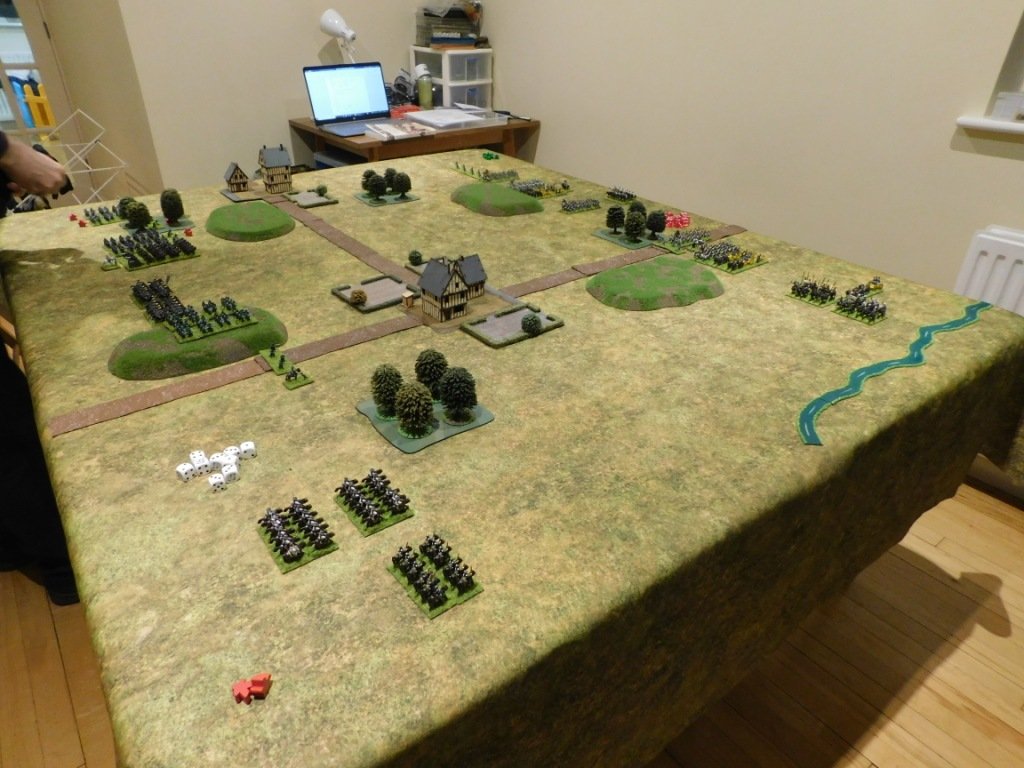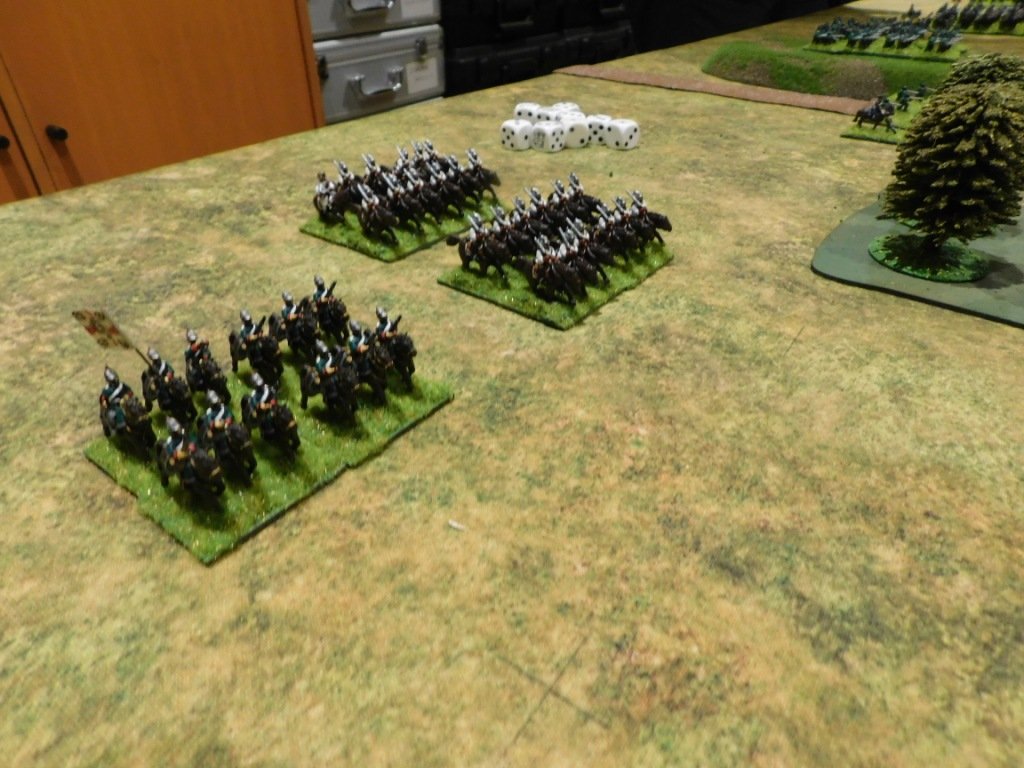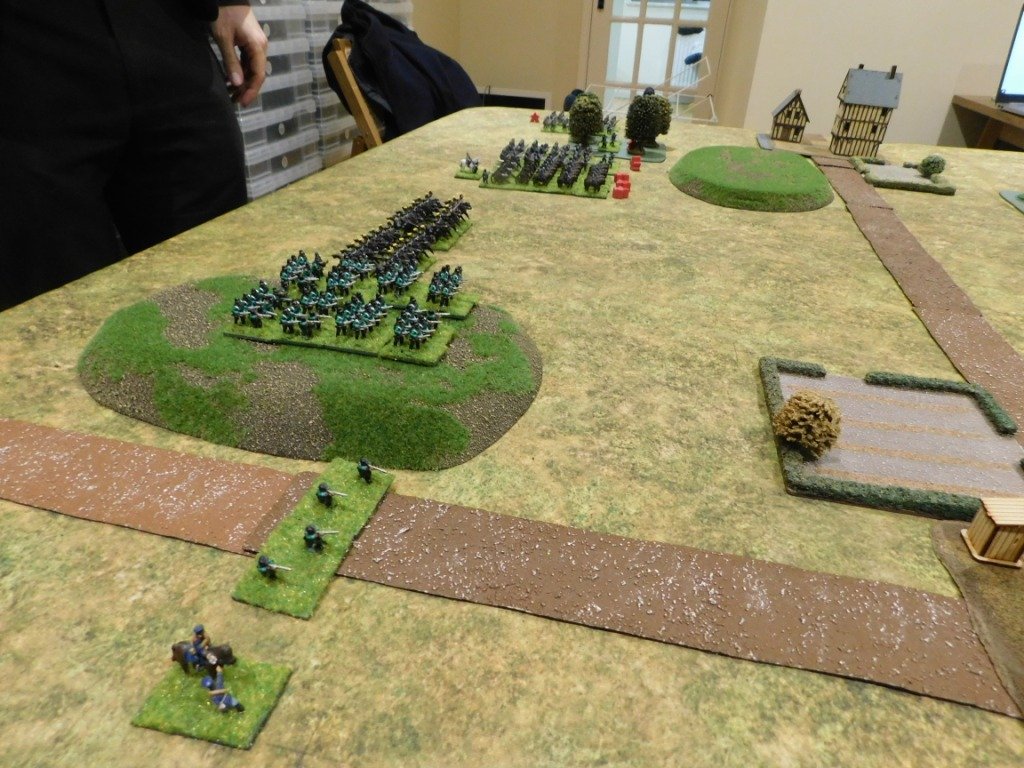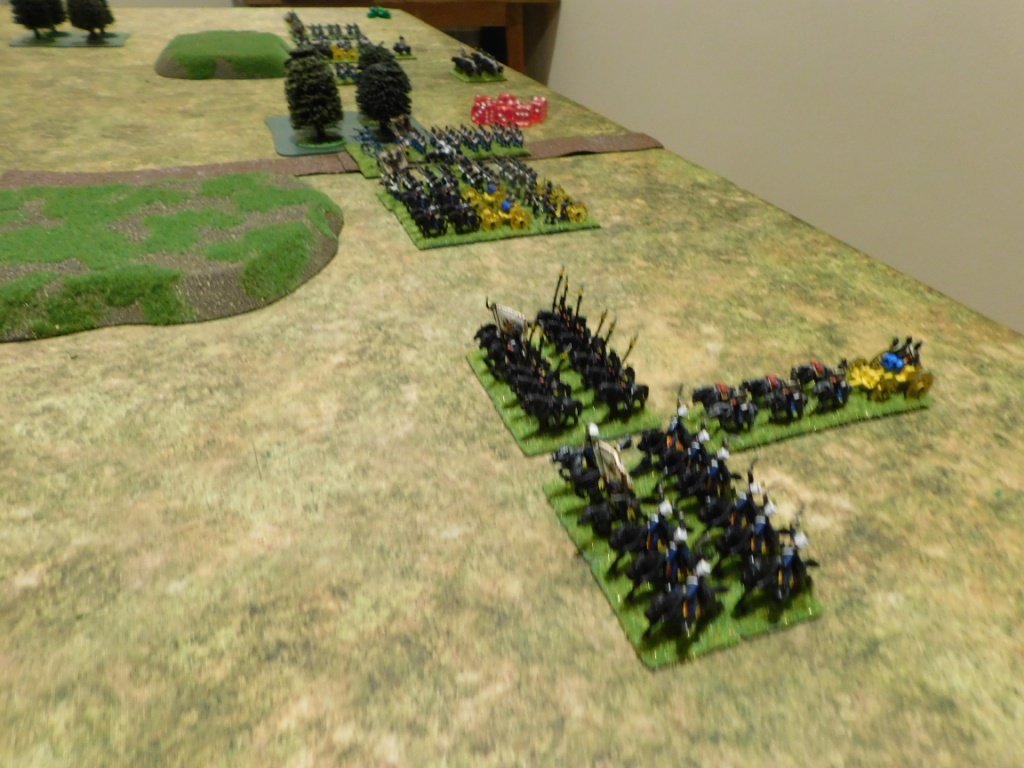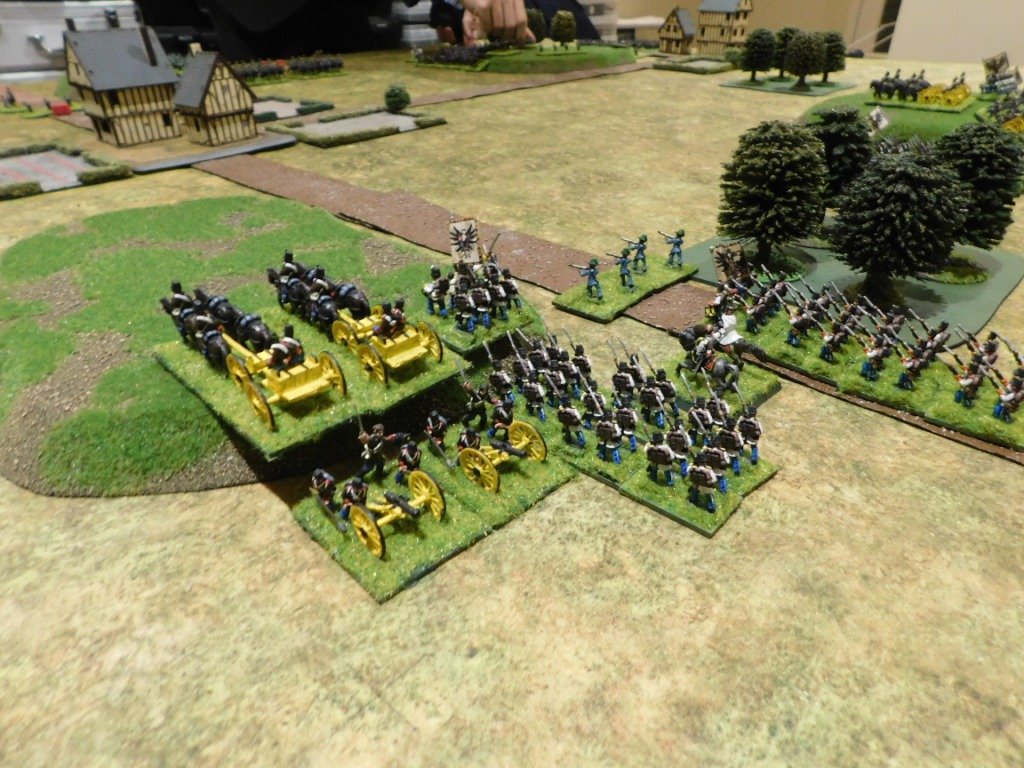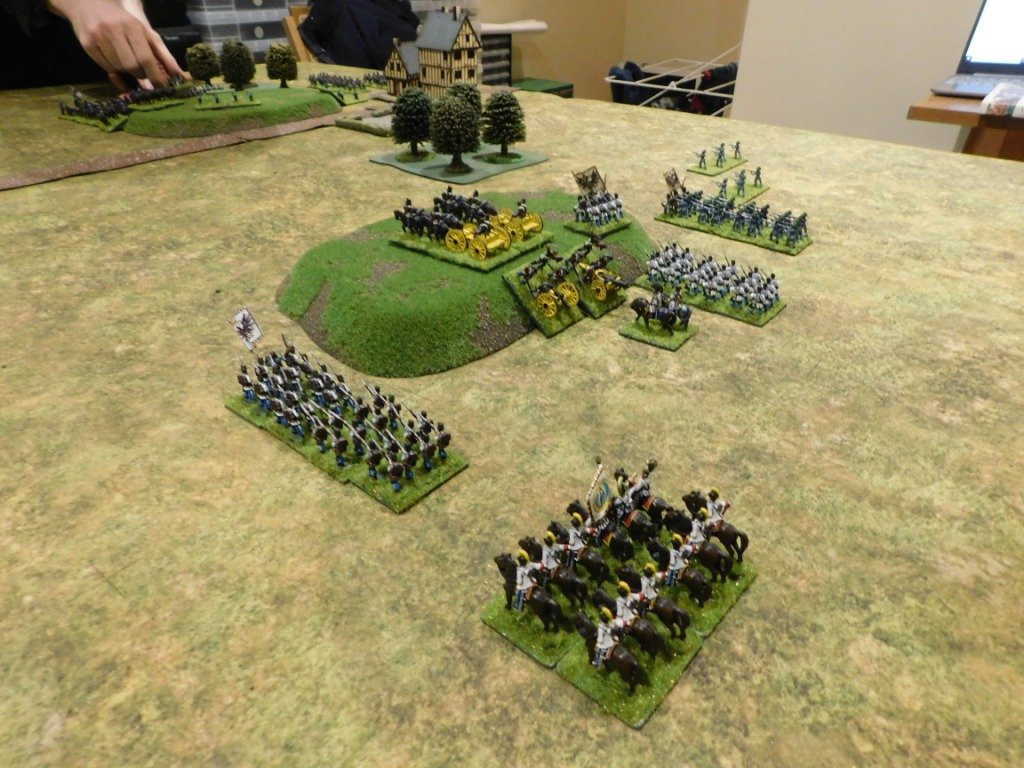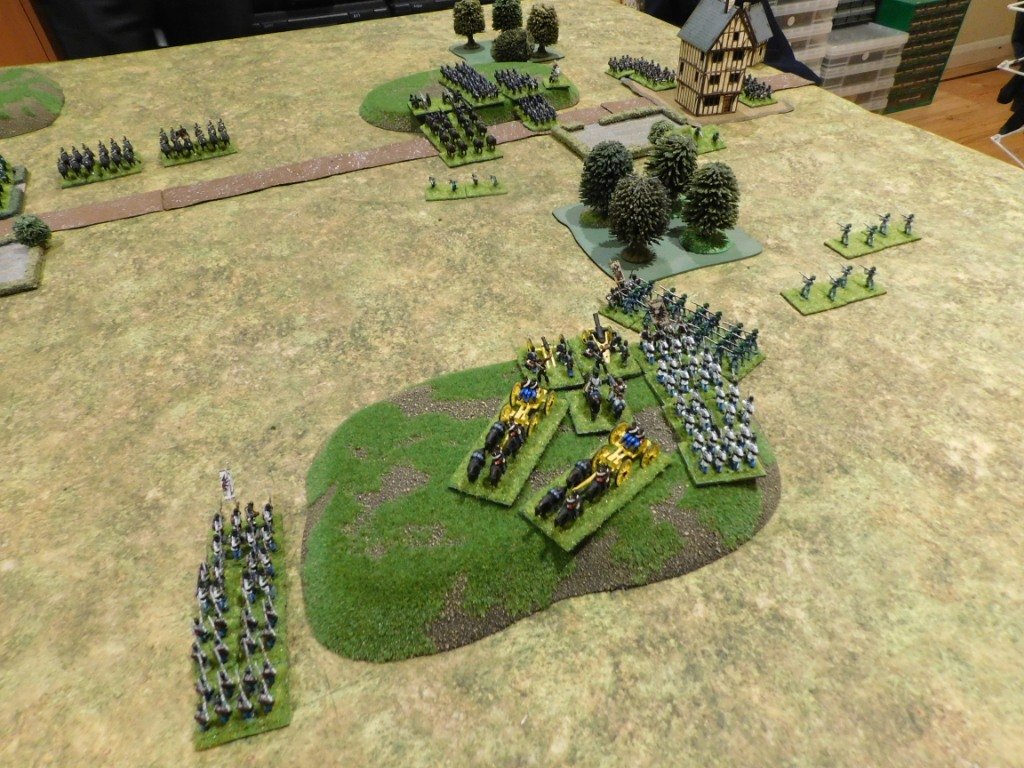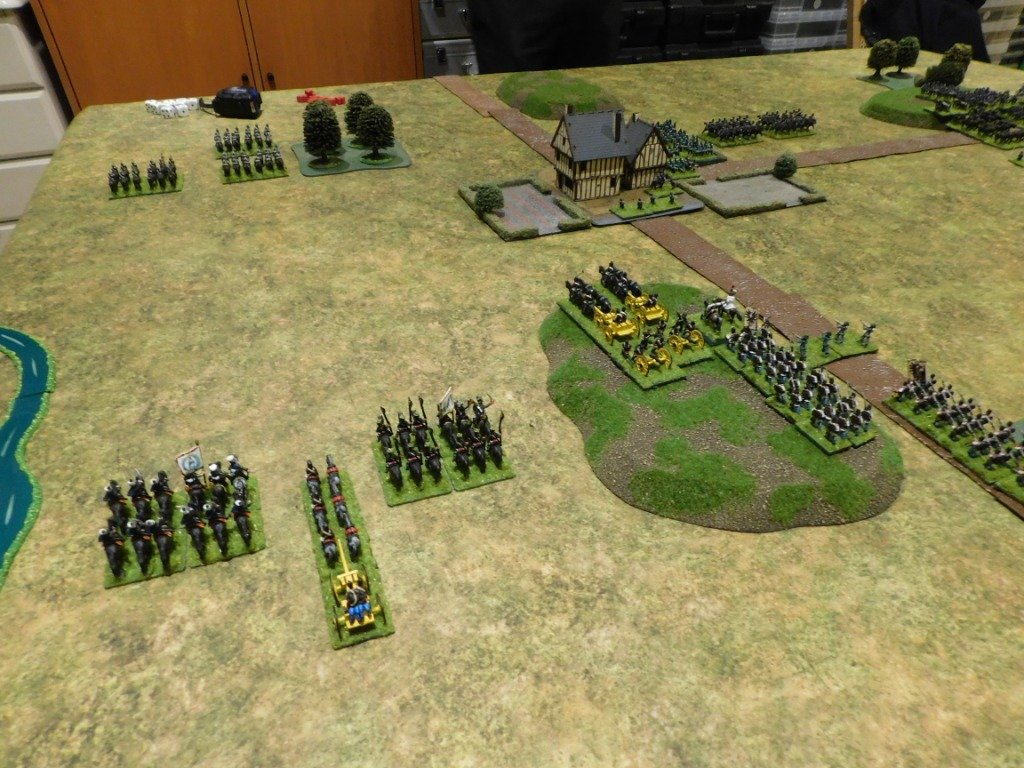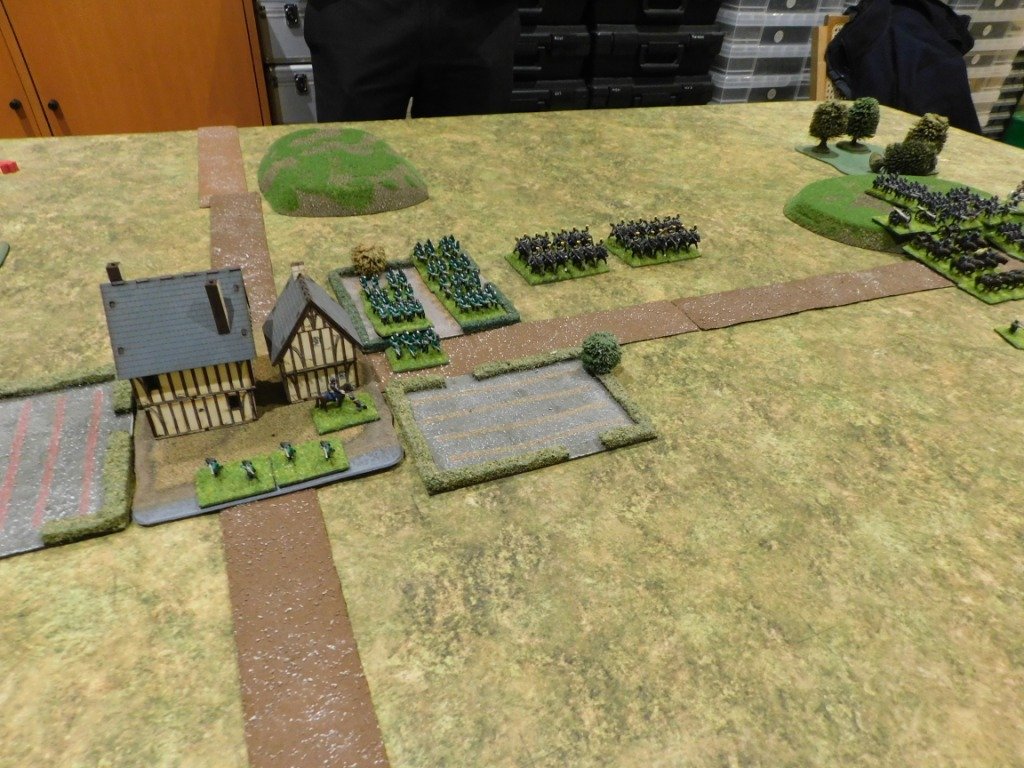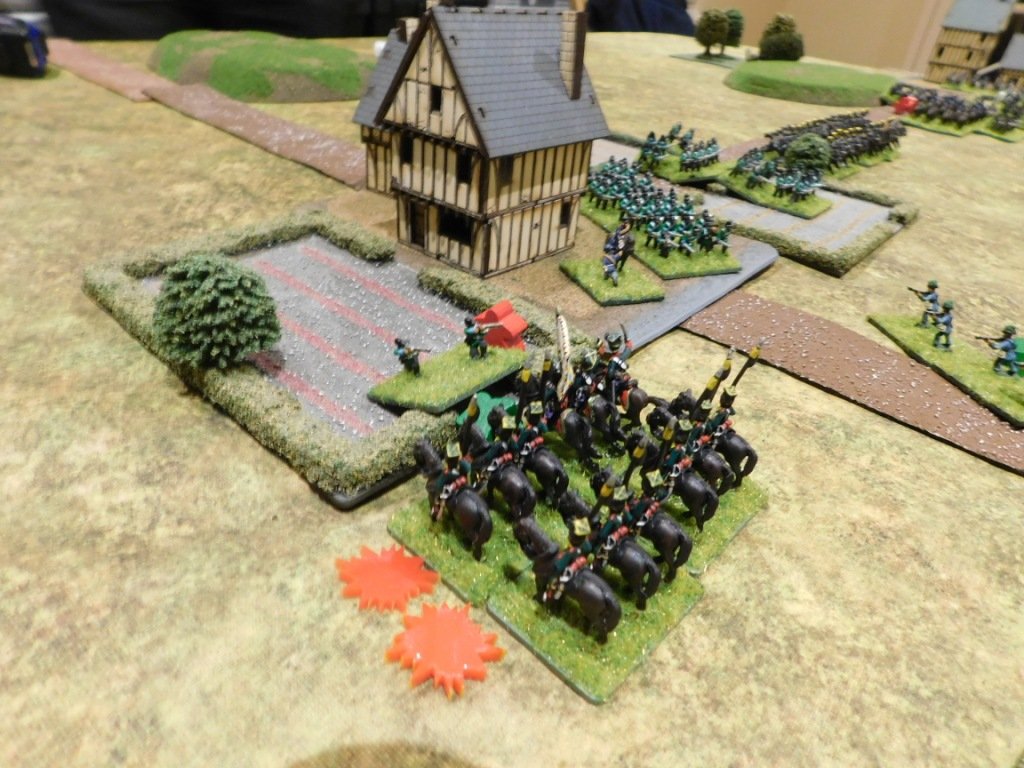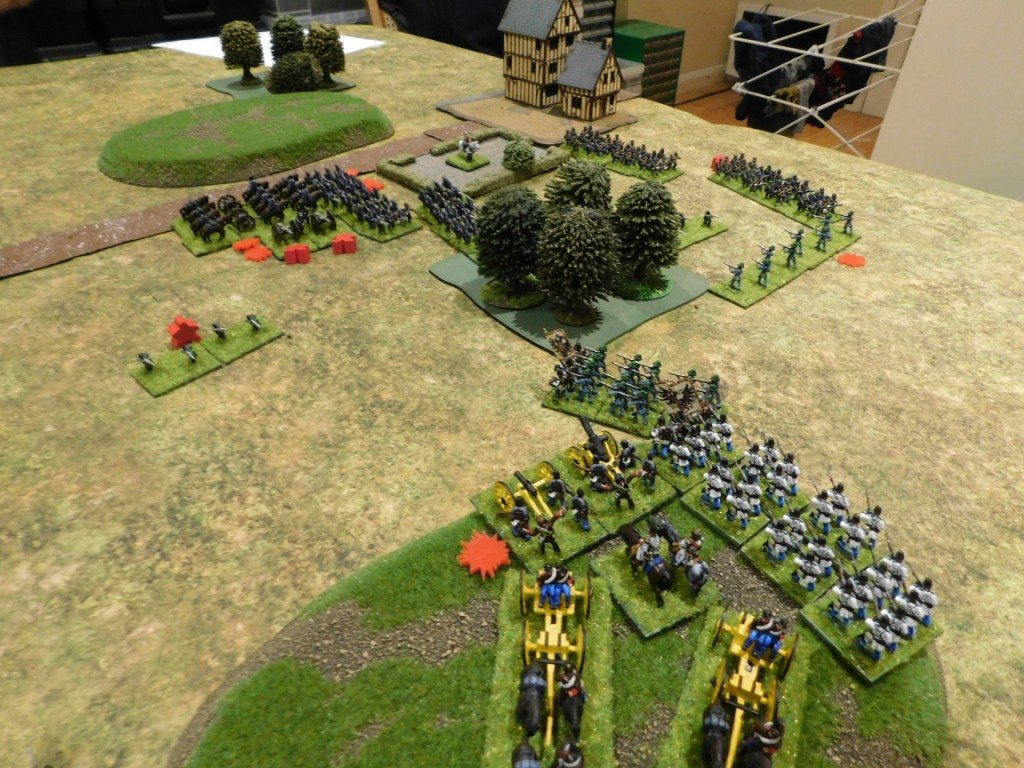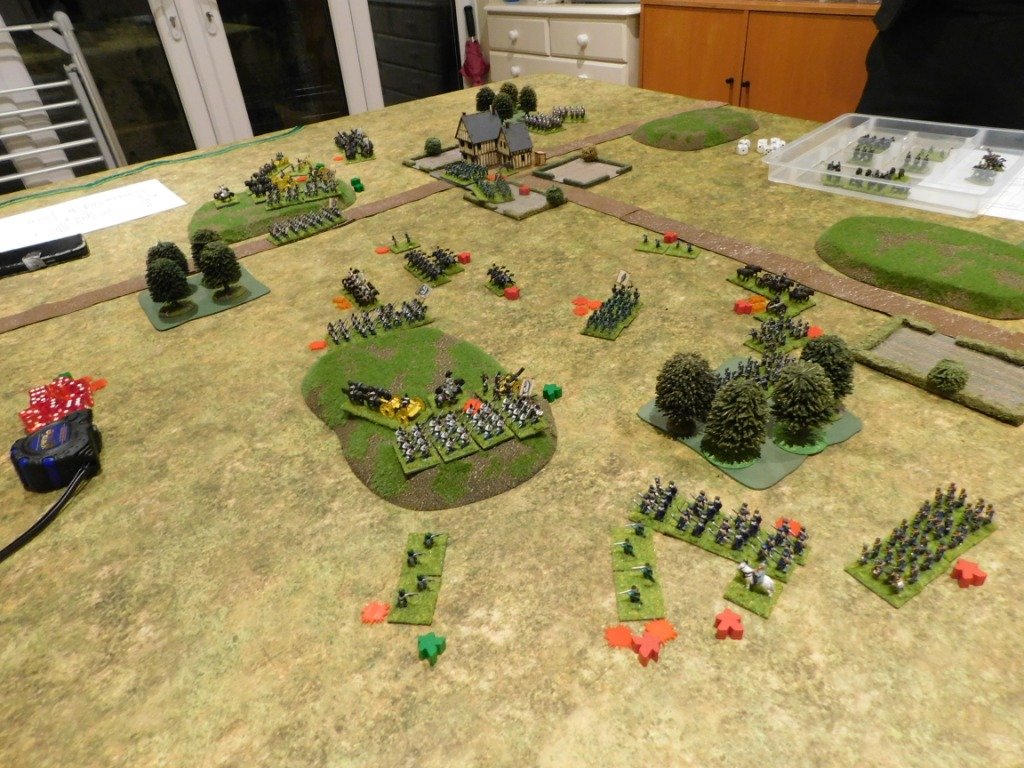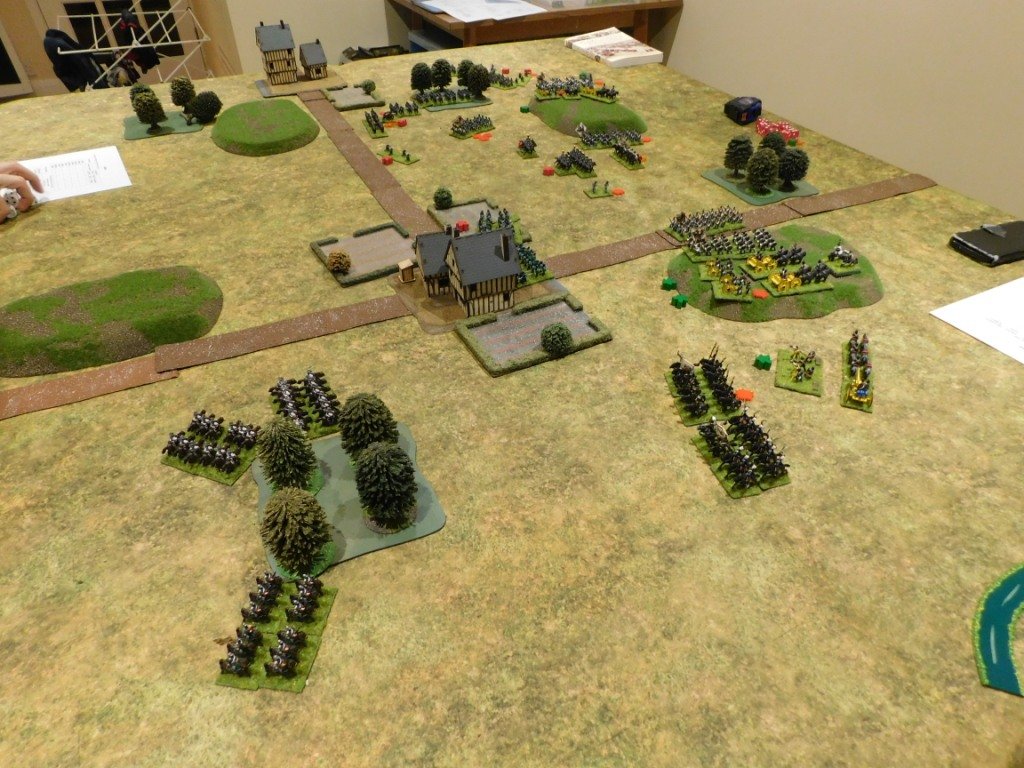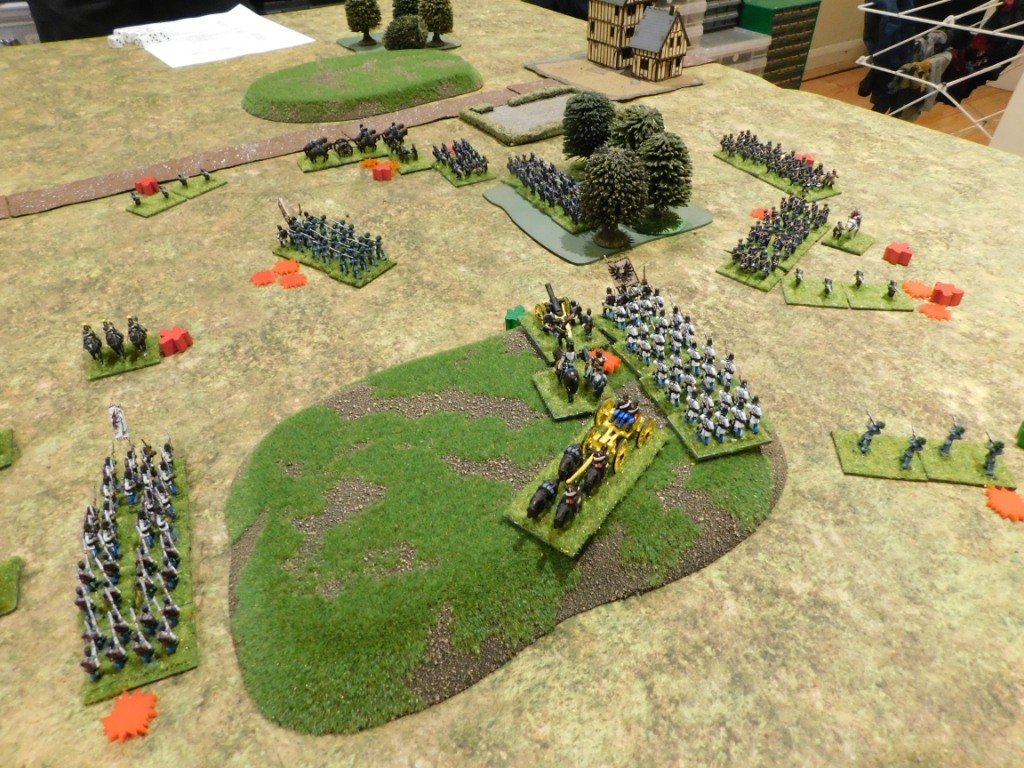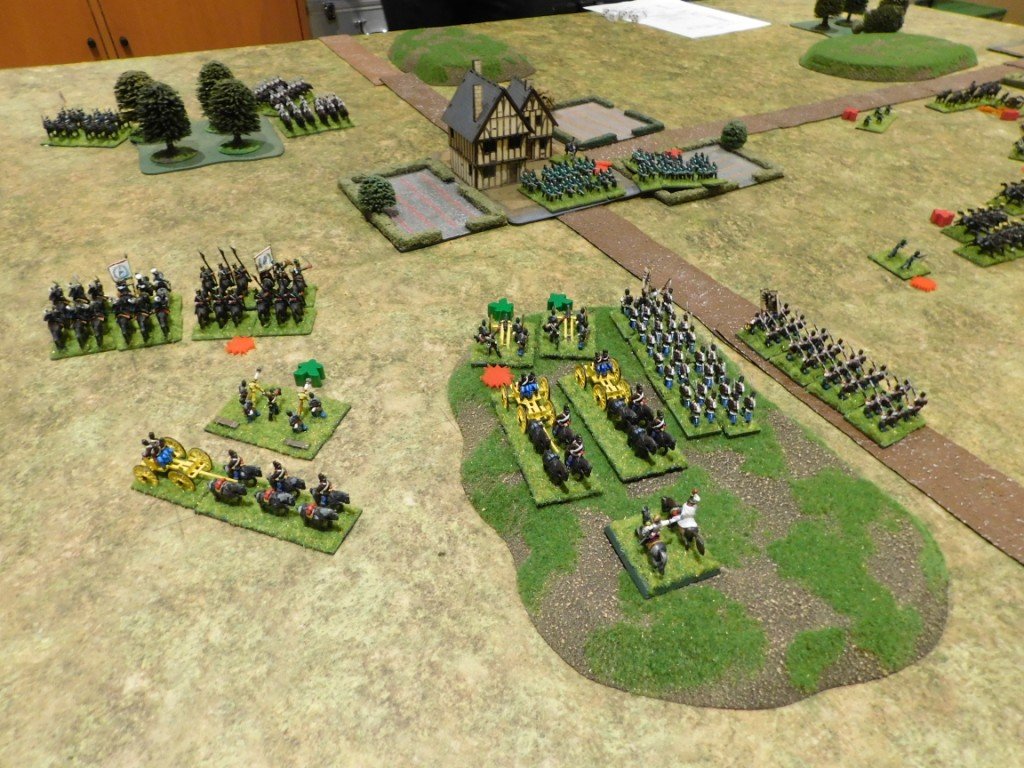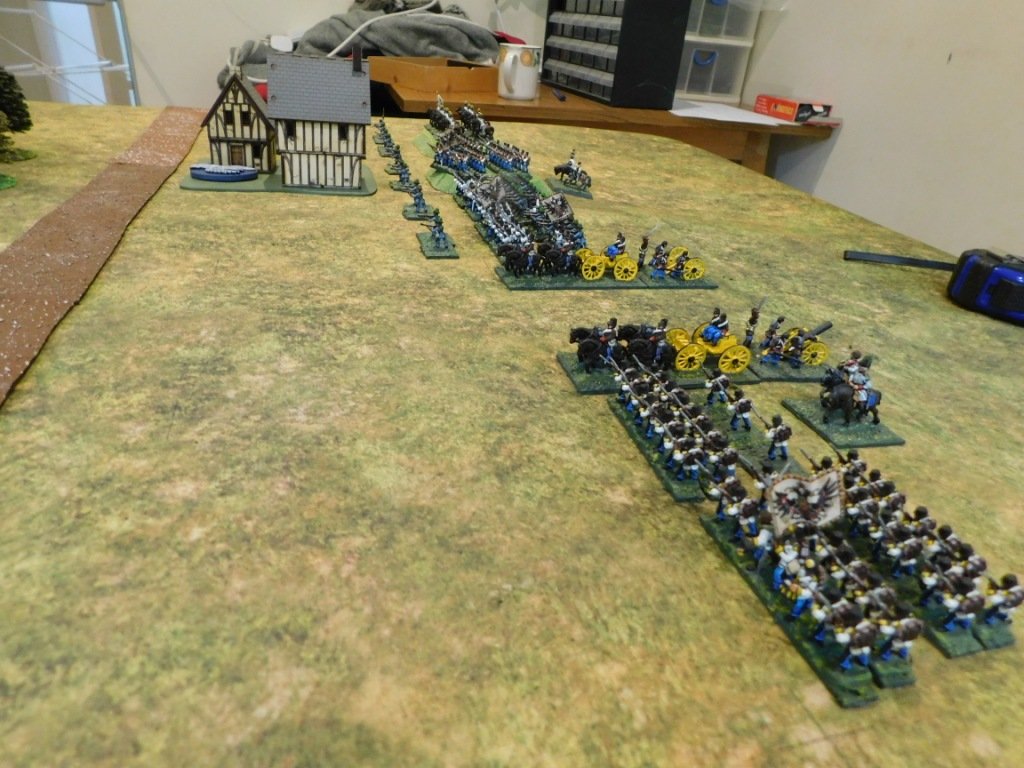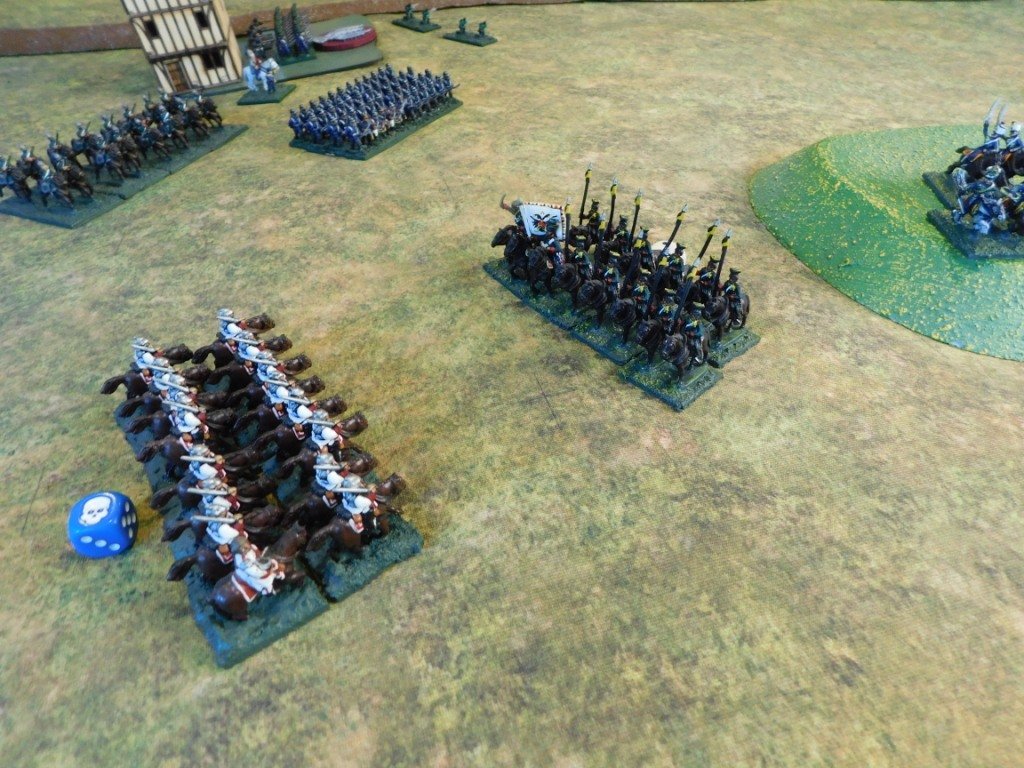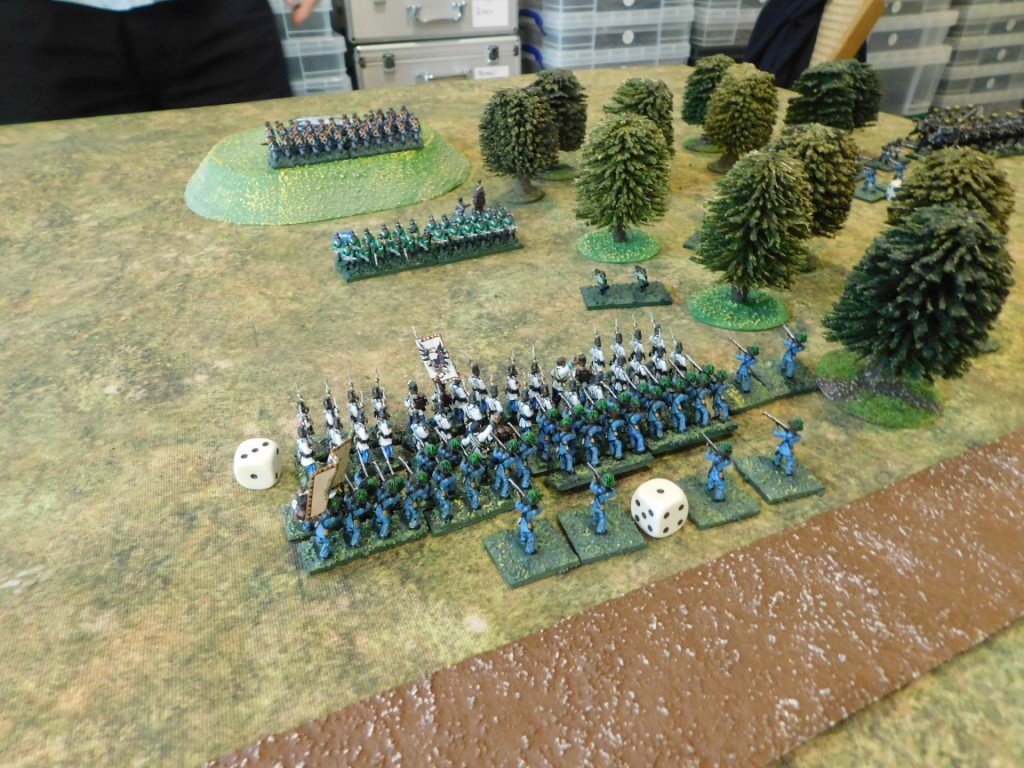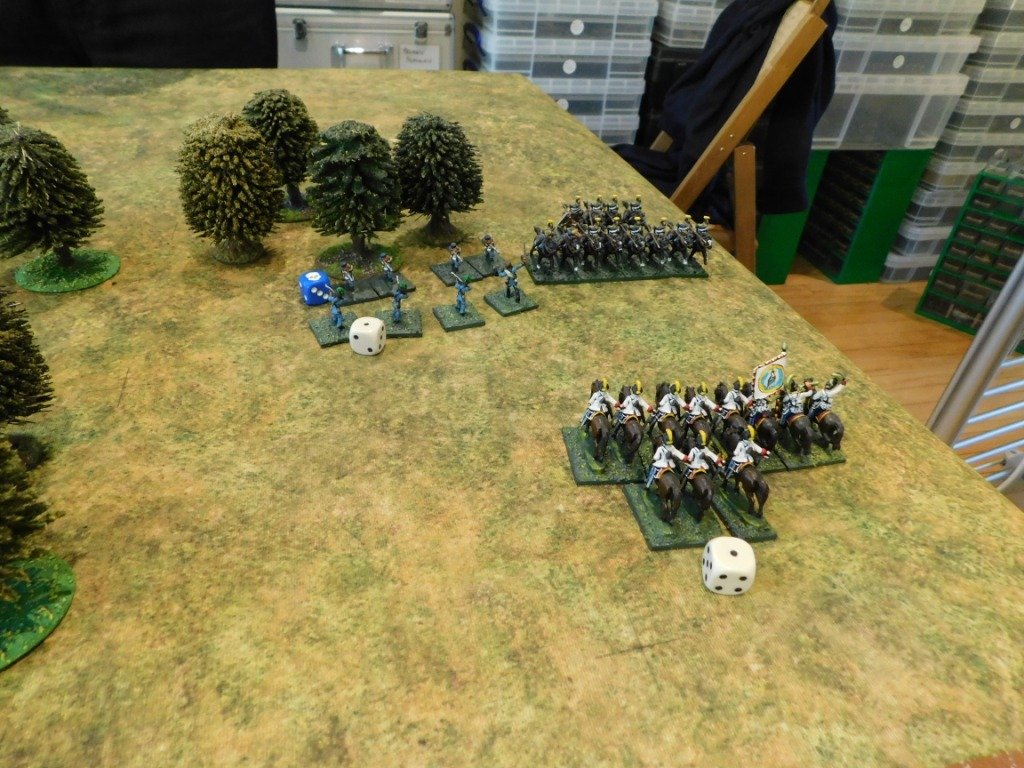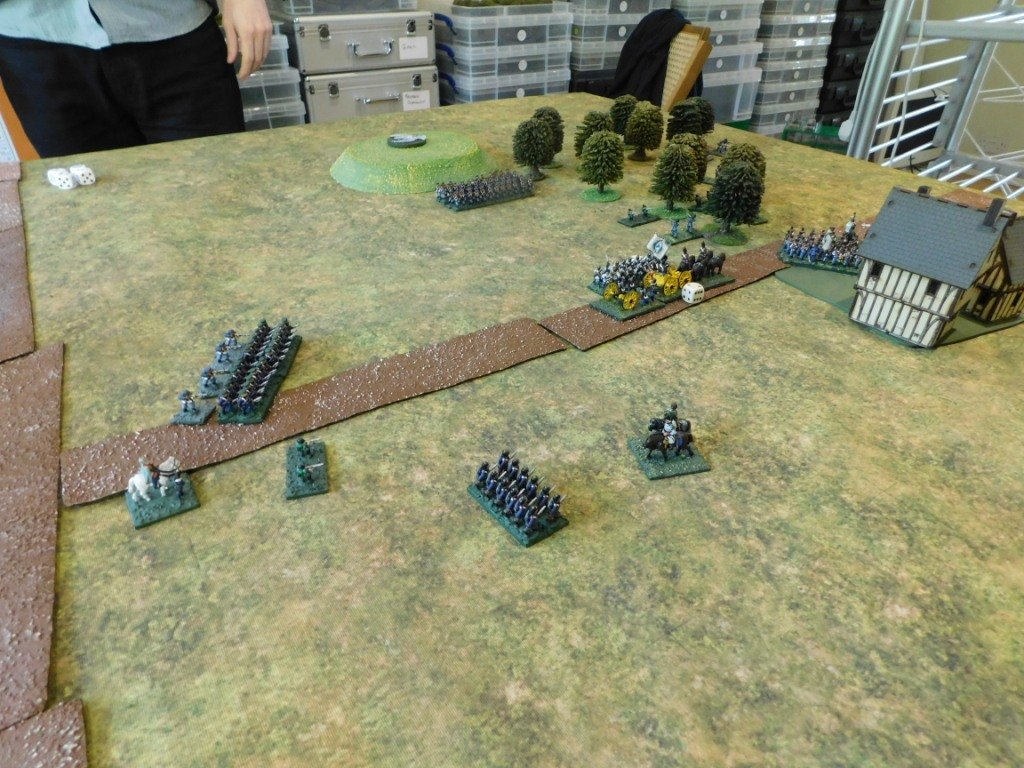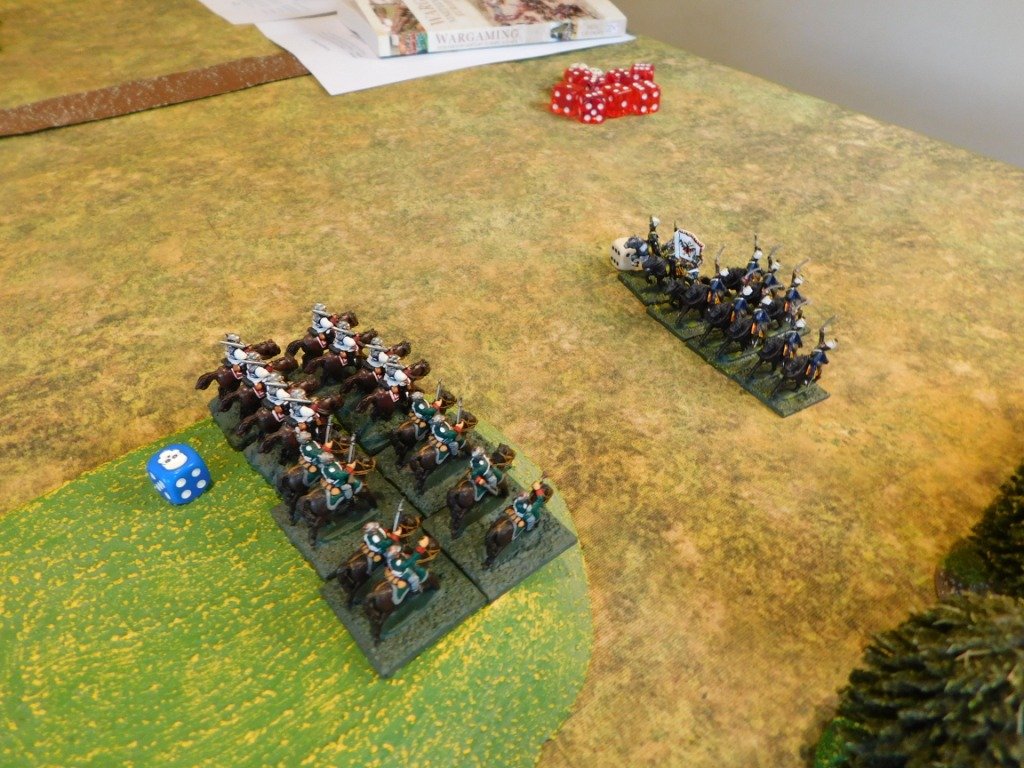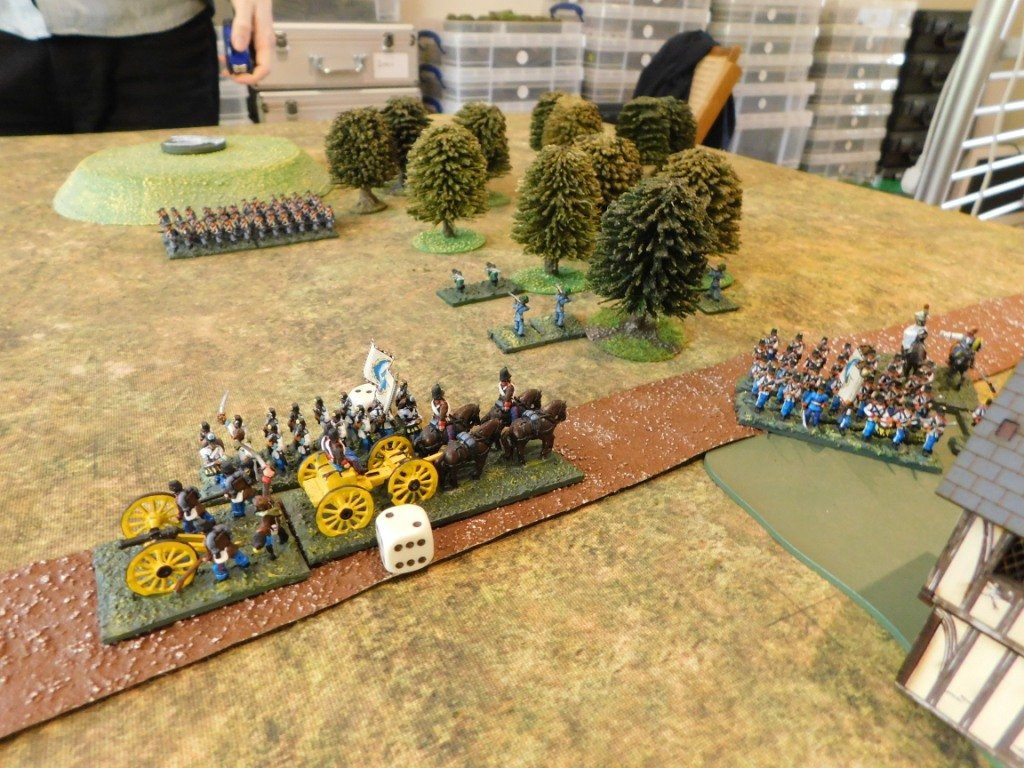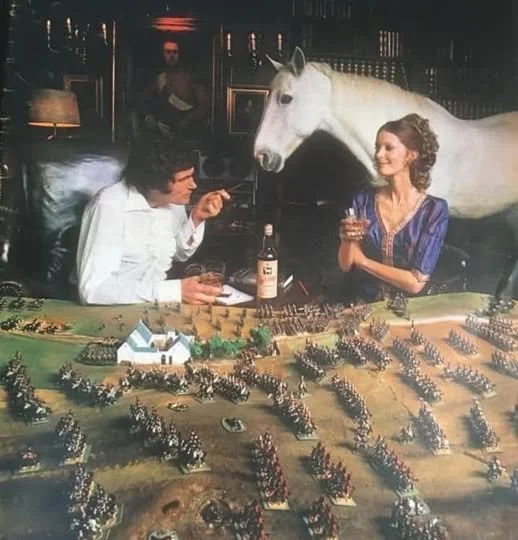FK&P AAR: Cossacks March Out Again
/Time for the Zaphorogian Cossacks to ride out again, this time with an away fixture at friend Bevan’s house.
It was an unusually shaped battlefield, and one criss-crossed by small streams and (impassable) lakes. There was also a chunk taken out of one corner, meaning any units deployed there ran the very real risk of falling off the end of the world!
After their first encounter ended in ignominious defeat, the Cossacks had re-organised their army: equipping their tabor wagons with light artillery and dropping the brigade of raw Cossack horse.
On this battlefield, therefore, I placed my up-armed tabor in the centre, infantry to the left and right of them, and a brigade of Tatars on the far right just in front of the edge of the world. That left me a brigade of horse in reserve just behind my tabor’s right flank.
As before, our opponents were the Lithuanian Polish, hereafter known as the Poles or the Polish. They had their infantry and artillery in the centre, with loads of really quite good horse on either wing.
The battle opened with the Poles advancing rapidly on either wing, and the game split into two halves.
On my right flank, my Tatars (one unit of veteran nobles and two units of light bowmen) took on four units of decent Polish cavalry. My lights were quickly sent fleeing from the field, but their veteran comrades managed to destroy two of the Polish horse units despite, at one stage, being hit in the flank.
Half the Poles who had been chasing my lights from the field then returned and, eventually routed my tired nobles, but I’d still effectively won that flank, certainly in terms of victory medals lost.
Meanwhile, on the other flank, waves of Polish horse, most of it rather decent, some of it the dread Winged Hussars, came forward and crashed onto the three Cossack foot units right at the end of my line.
[The Winged Hussars were being represented by only their bases as painting their leopard skins had caused a delay in production. This was quite unnerving…as the temptation was to visually dismiss the units that were actually the most deadly on the table!]
Time and time again the Polish cavalry crashed into one unit of Cossack Moloitsy militia: a unit that just refused to break. Two light units and two medium units of Polish cavalry were sent packing before, finally, the Moloitsy gave way, leading to a general crumbling of that flank.
So exciting was this passage of play that I don’t actually have many photos of it. Below, left is the first wave of Polish cavalry moving forward. Below, centre is the situation after the first wave of Polish cavalry has been repelled, with the black-base-Hussars moving forward in the background. Below, right is after the Hussars have finally shattered the Moloitsy infantry.
Meanwhile, the Polish infantry had also split into two halves. On my right centre, they advanced towards the Cossack foot brigade amongst the trees and rough ground in the bend of the river. A firefight broke out between the two infantry forces, with each of us eventually losing a unit.
On my left centre, after hanging back for some time, the other Polish infantry brigade came forward. They advanced towards the left hand tabor unit but so keen was Bevan to get them into action at the same time as his Hussars were wiping out my Moloitsy that he left their flank exposed.
No sooner seen then acted upon: one of my reserve cavalry units, Tatar lights, smashed into their flank and smashed them from the field. The Tatars went on to knock off a unit of enemy Tatar light horse (Taras Bulba anyone?) before retreating back to safety.
The climax of the battle was now upon us. Before my Cossack Moloitsy on the left broke and ran I had been comfortably ahead: nine victory medals verses the three that Bevan had left. Once my left flank had broken, I was down to three victory medals. Could Bevan now snatch victory from the jaws of defeat?
As his troops massed for further charges into my left flank, the battle was actually decided back on the right centre, where Bevan’s remaining infantry unit had retreated back from its firefight with some of my Registered Cossacks in order to re-group.
I followed up, also deploying my final reserve: a unit of poor quality mounted Cossacks. These managed to pin the retreating Polish Haiduks in place, giving my Registered Cossacks time to follow up and hit them in the flank. They crumbled, their victory coins were lost, and the battle was mine!
The gallery below shows the initial clash between infantry lines on the right center. The position after this initial clash, and then the climactic moment mounted and Registered Cossacks dashed the enemy Haiduks from the field:
So a first victory for my Cossacks, but a very hard fought contest won only by the narrowest of margins.
Again the Poles avoided frontally assaulting my tabor wagons, concentrating on trying to win the battle by killing all my other troops. In this game that actually worked in my favour a bit: my tabor were free to deploy their new light guns with significant effect and the terrain was such that my infantry could hold on for long enough before fleeing the field.
For me, I tried to avoid throwing my cavalry away. Admittedly the veteran Tatar noblemen played a blinder and did much better than they should have, but keeping the other cavalry brigade in reserve worked really well: I would only have lost them to the mass of enemy cavalry as it advanced forward, and this way I was able to shore up my line and then exploit the retreat of the enemy infantry when the time was right. For my next outing, I think I’ll add a unit of artillery to the roster, sacrificing some infantry Gallant Gentlemen to do so. After all, I can only use them if I’m attacking, and my infantry won’t charge enemy horse!
Here’s a pic of the table at the end of the game.
IABSM AAR: The Defence of Stonne
/Here’s an AAR that dates back to last year: Steve from the excellent Bleaseworld blog playing one of Phil and Jenny’s amazing early war IABSM games down at Bristol Independent Gamers.
Some lovely eye candy, so I recommend clicking on the picture below to see all:
IABSM at Winter Wonder Lard
/Last weekend saw another excellent Winter Wonder Lard at Bristol Independent Gamers. On show were games of Chain of Command, Sharp Practice, Strength & Honour, What a Cowboy and, of course, I Ain’t Been Shot Mum.
The IABSM game was based on the tank battle on the Calais - Dunkirk Road, near St.Omer on 22nd May 1940.
On That day a patrol sent out from the Calais defences reported German tanks on the road between Calais and Dunkirk and fighting towards St.Omer. Staff Officers at Calais disputed this, stating that there were no substantial German forces within 30 miles of St. Omer and this could only be a stray reconnaissance patrol.
A British Force was ordered towards St.Omer to drive off these random German troops, but came into contact with lead elements of 1st Panzer Division, who were attacking French troops on the edge of the town.
Click on the picture below to see all:
IABSM AAR: St Lambert
/Dan Albrecht had a nice game of I Ain't Been Shot, Mum last week at a St. Albans, Vermont mini-con recreating the defense of St. Lambert-sur-Dives on August 20, 1944 by Canadians against the escaping 2nd Panzer Division. This AAR is taken from the IABSM Facebook Group. Click on the picture below to see all.
Cossacks Take To The Field (Briefly!)
/My first game of the year, so it was only right that the Cossacks finally take to the field with their opponents, the Polish/Lithuanians (hereafter known as the Poles/the Polish), provided by friend Bevan. So new to the table were both armies that the Poles hadn’t even been properly based yet.
The table was set up quite differently to our usual ECW terrain: no hedges and loads of irritating patches of rough or impassable ground.
We used the excellent eastern front modifications to For King & Parliament available on the Tales From A Wargames Shed blog.
View from the Polish side
The Poles arrived with a fearsome army: two units of Winged Hussars; four units of Pancerni horse; three units of Petyhorsy horse; three units of Tatar mounted bowmen; and four infantry Haiduk units.
Not properly based! Are the shades of the wargaming room to be thus polluted?
To oppose them, my brave Zaporogian Cossacks fielded four tabor war wagons; two brigades each of one unit of Registered Cossacks and two units of Moloitsy; and two Tatar warbands, one of two units of mounted bowmen, the other the same but with a unit of Tatar noble lancers as well.
Tabor in the centre, then the infantry, then the cavalry on the wings.
Here’s how the game went:
In summary, the Poles sent their cavalry forward on each wing. This proved too strong for my horse, who were mostly Tatar bowmen and reluctant Cossacks, leaving the end of my infantry/tabor line exposed.
My musket fire proved ineffective (I think it must have been raining) and although they did cause the Poles some damage, the Moloitsy infantry then began to crumble.
As the battle ended, the Poles were about to fall upon the Registered Cossacks whilst my tabor still sat in the centre watching what was going on!
Aftermath
An excellent game (despite the result!) and it was good to get back to gaming and give my latest army a baptism (of fire!).
IABSM AAR: Home Run at Osmanville
/An excellent I Ain’t Been Shot Mum battle report for you to look at today, from Scott Miquelon’s equally excellent Little Soldier Painting Studio blog.
Scott has created a comic-book style AAR showcasing his solo game using the Home Run at Osmanville scenario from the 29 Let’s Go Large article in the TFL 2014 Christmas Special.
Click on the picture below to see all:
More Marlowe to Maidenhythe AARs
/As mentioned in previous posts, one of the things I like about publishing scenario packs (in addition to the extra money to buy more figures) is reading people’s AAR of the games therein.
I’ve featured a round of reports from the first scenario of the Marlowe to Maidenhythe pack, The Attack of Marlowe, and am pleased to say that the people playing through the campaign seemed to have enjoyed the first game well enough to play through the second: Widbrooke Common.
Here a link to the Blunders on the Danube blog where disaster is narrowly avoided during the game when one of the tables used collapses! Despite the unexpected earthquake (this is Berkshire after all!) this is a great looking game with some lovely figures deployed. Here a pic:
Then it’s on to the Troop Time! blog, where Widbrooke Common has also been played out, thankfully without any near-catastrophes.
The author of the blog, Zanoni, does mention that he’s disappointed that the M2M scenarios aren’t linked more closely, but as I’ve explained before, that’s the way they are designed.
As the first multi-game supplements for FK&P, I wanted M2M and SoN to be scenario books that primarily provided people with lots of easily run games i.e. without any barriers to playing any of the 24 scenarios provided in any order.
I did think about going the whole hog and writing a campaign based on a dependency tree and with characters/units who can progress or expire (much like I do for my IABSM scenario packs) but felt that, at this stage, what FK&P needed was just lots of individual games that people can play
That said, I also wanted to link them together in some way, so there's a strong campaign thread running through each pack, the games feature the same people and units throughout, and there a neat tracker provided so that players can keep a running score of how they are doing: hopefully a good compromise, "best of both worlds" product.
So hopefully Zanoni will keep playing through the pack: he certainly seems to be enjoying himself so far.
Now all we need is the Iron Mitten to catch up with his Widbrooke Common game!
IABSM AAR: South of Cherbourg
/Here’s a quick IABSM battle report from Sergeant Steiner’s excellent blog.
The Sergeant played through one of the free scenarios in the main rulebook: the South of Cherbourg game. This is an all infantry scenario with regular Wehrmacht defending against advancing US troops in Normandy in 1944.
Click on the picture below to see all:
IABSM AAR: Blenneville or Bust! #4B Reversed
/Here’s an after action report that shows how flexible the IABSM scenario books are.
James Moulding and friends played scenario #4B from the Blenneville or Bust! scenario pack, but with the roles reversed i.e. in the original game, the British are attacking defending Germans but in this game it’s the British defending with the Germans attacking.
Click on the picture, below, to see all:
Note that this report is taken from the IABSM Facebook page. I hope James doesn’t mind me reproducing it here.
IABSM AAR: Viking Panzers in Central Poland
/Another cracking I Ain’t Been Shot, Mum battle report from the pen and camera of Mark Luther.
It’s another 6mm battle fought at the Gigabyte’s cafe, and this time features a somewhat generic game based on actions to the east of Warsaw in August 1944 where the Soviets had sent masses of tanks through thin lines of the German defenders. The panzer units were then forced to scramble to cut those units off before they totally disrupted the front.
Click on the picture, below, to see all…
IABSM AAR: Anzio #10: Highway 7
/Another great 6mm I Ain't Been Shot Mum game from Mark Luther played at Gigabites Cafe in November 2021.
The scenario is taken from the Anzio: Wildcat to Whale scenario pack and features US infantry and armour assaulting a collection of four farmhouses held by men from the Herman Goering Panzer Division.
Click on the picture below to see all:
19C AAR: The Battle of Lederhosen
/With both the Austrians and the Prussians now rebased (see previous posts) it was time to get the armies back onto the tabletop. This would be their second outing after over twenty years in storage!
The Austrians
1st Division
1st Line Battalion
2nd Line Battalion
One Jaeger Company
Two artillery batteries
2nd Division
1st Jaeger Battalion
3rd Line Battalion
Two Jaeger Companies
Two artillery batteries
Cavalry Division
1st Uhlan Regiment
1st Hussar Regiment
Army Reserve
1st Dragoon Regiment
The Prussians
1st (Jaeger) Division
1st Jaeger Battalion
2nd Jaeger Battalion
One Jaeger Company
1st (Line ) Division
1st Guards Battalion
2nd Guards Battalion
1st Landwehr Battalion
2nd Landwehr Battalion
One Jaeger Company
Three artillery batteries
Heavy Cavalry Division
1st Cuirassier Regiment
2nd Cuirassier Regiment
1st Dragoon Regiment
Light Cavalry Division
1st Uhlan Regiment
2nd Uhlan Regiment
And that was where we had to end the game unfortunately.
I was certainly in a very good position on my left, honours were even in the centre, but I was definitely losing the right,. So we called it a draw, with a slight strategic advantage to the Prussians balanced by the extra casualties they had taken.
A great game, and I’m now rebasing the French so that they can join in the fun!
19thC AAR: Austrians vs Prussians
/As we’d been playing For King and Parliament almost exclusively for the past few months, my regular wargaming opponent and I fancied a change. He’d spotted my fairly extensive collection of 19th Century figures, so suggested we dust them off and have a game.
Good idea, says I, so the next question became a discussion about what rules to use. I wanted something simple, with no need for protractors and laser pointers and the like, so we thought we’d give Neil Thomas’ Wargaming 19th Century Europe 1815-1878 a try.
This compact little booklet contains a wealth of information. There’s a large background section followed by six pages of rules and then large numbers of army lists, battle scenarios and historical information.
Six pages of rules sounded good to me, especially as I knew that I would need to re-base my collection to play any commercially available rules, so would only need to expend a little brain power to work out how to use my existing figures and play-test the system before making any sort of re-basing decision.
We set up a quick encounter game using as many of my Austrian and Prussian figures as possible, and set to…
The Battle
As I said, above, we used my existing figures based as is, and made loads of mistakes with the rules - despite their simplicity!
I won’t therefore do a full AAR, just a gallery of the action. Suffice to say that my brave but outnumbered Austrians were soundly beaten: the breachloaders used by the dastardly Prussians proving highly superior to my Lorenz rifles!
It was a most enjoyable game, however, with the rules proving simple yet infinitely subtle. It certainly had the feel of a 19th Century battle: very pleasing as many rulesets for the period, in my experience, are a Napoleonic battle with a bit of advanced weaponry tacked on!
I’ve now started re-basing my troops to suit the system (and many other sets as there’s nothing too outre about what’s needed) and we’ll have more of a proper game next time.
Oh, and it’s worth mentioning that none of the figures featured had been on the tabletop for over 20 years!
FK&P AAR: Disaster at Skirmett's Orchards
/Here’s a battle report from the playtest of the final scenario in my newly-published Siege of Norchester scenario pack for the English Civil War rules, For King & Parliament.
As the title of this post suggests, this was an absolute disaster for my Parliamentarians!
“Went the day well, my dear?”
“No it bl**dy didn’t!”
The day started very well. Above is a view from behind the Royalist lines, with the village of Skirmett in the centre of the table. My plan was to win on the wings then envelop the Cavaliers in a “horns of the buffalo” manoeuvre.
Northern Donkey Wallopers to the Front!
On my left wing, I had a brigade of Borders horse: poorly-mounted, but out-numbering the opposition. The lancers on the far left were quite nasty in a first clash, so I was pretty happy that I could get an advantage here.
The centre and right
I was a bit more concerned about my right wing, where the Roundheads had quite a few units of Swedish-style horse versus my monolithic Dutch-style troops, but my infantry were nearby and could always pore fire into the flanks of any rampaging Royalist cavalry before they got too close.
Back on the left wing, the two lines of cavalry smashed in to each other: complete disaster!
I may have gone a little over the top on the disorder markers!
Let me explain. I got my tactics just right and ended up with three cavalry units facing just the one of his. Not only that, but I was uphill charging downhill. Yes, I had both my CinC and the Brigade Commander with the central unit, but officers casualties are quite rare, yes?
Wrong!
In the first clash I lost both my CinC and the Brigade Commander: both killed outright!
This was particularly painful as in FK&P not only are officers really useful for, er, officering but, representing the cult of personality around so many ECW commanders, your CinC is worth a great many Victory Medals. Combined, I lost just about a third of all my Medals with the death of just two men! This obviously meant that even if things went 50/50 from now on, I would lose the game in short order.
Anyway, we decided to play on for a bit…
Even Stevens on the Right
Another cavalry clash on the right, with my troopers getting an initial advantage.
The Centre standing Firm
Unfortunately that advantage didn’t last. Lady Luck again deciding that she was for the King!
Centre cavalry unit couldn’t even last long enough for the infantry to intervene!
Which meant that when my already battered left flank finally gave way, I was out of Victory Medals and on the stage coach to Losertown!
The Left Crumbles
So a very quick battle mainly due to the surprising death of my CinC and a cavalry brigade commander. Still an enjoyable game and, looking for the silver lining, the speed of my defeat gave us time for another game…
FK&P AAR: Napshill Downs
/Regular visitors will be aware that last Friday saw the release of my second scenario pack for the For King & Parliament English Civil War ruleset: The Siege of Norchester.
The pack contains twelve free-standing, fictional scenarios in a loose chronological order. It tells the story of the investment of the fictional, Royalist-held city of Norchester. It begins with the Parliamentarians gradually pushing the Royalist foraging parties back into the city itself, then looks at the Royalist attempts to delay the construction of encircling works. There’s an assault on the outskirts of Norchester and then a Royalist attempt to get a messenger through to the King to ask for aid. Finally, there’s the arrival of a Royalist relief force, the fall of Norchester and the attempted escape of the main Cavalier protagonists. The same officers and units are used throughout the campaign, and it is hoped that the players will come to adopt and recognise them as their own or the enemy.
The pack is designed to give players who don't have enough time to write their own scenarios a number of games that they can play with little or no preparation. All you have to do is print out the game and player briefings, set up the table according to the map, break out the figures and cards, and start the first turn. You don't even need to print the pack out in full: just the pages you need for the scenario you're going to play. The games can be played either as a series of linked games or as a collection of one-off battles. To emphasise: each scenario is free standing and they do not have to be played in any particular order…but it is anticipated that players will play them in order as a campaign, keeping a running total of each sides’ score as they go along. The pack provides a Campaign Record Sheet as an easy way of doing so.
Finally, although specifically designed for FK&P, with a little work the scenarios can be adapted for any set of English Civil War/Renaissance rules: the basic elements of why, where and with what each side is fighting being largely common to all systems.
Napshill Downs
An important part of the preparation for launch is to playtest all the scenarios in the pack, and below you will find a gallery of images from the playtest of scenario #11: Napshill Downs.
As one of the later scenarios, the background is that Norchester has already fallen so some of the Royalist erstwhile defenders are trying to make their escape from the region in order to continue the fight against the Parliamentarian traitors elsewhere. The Roundhead force (which I was commanding) is tasked with bottling them up and destroying them.
This was one of those games that went wrong for me just about right from the beginning when I completely cocked up my opening moves! Read on to share my pain!

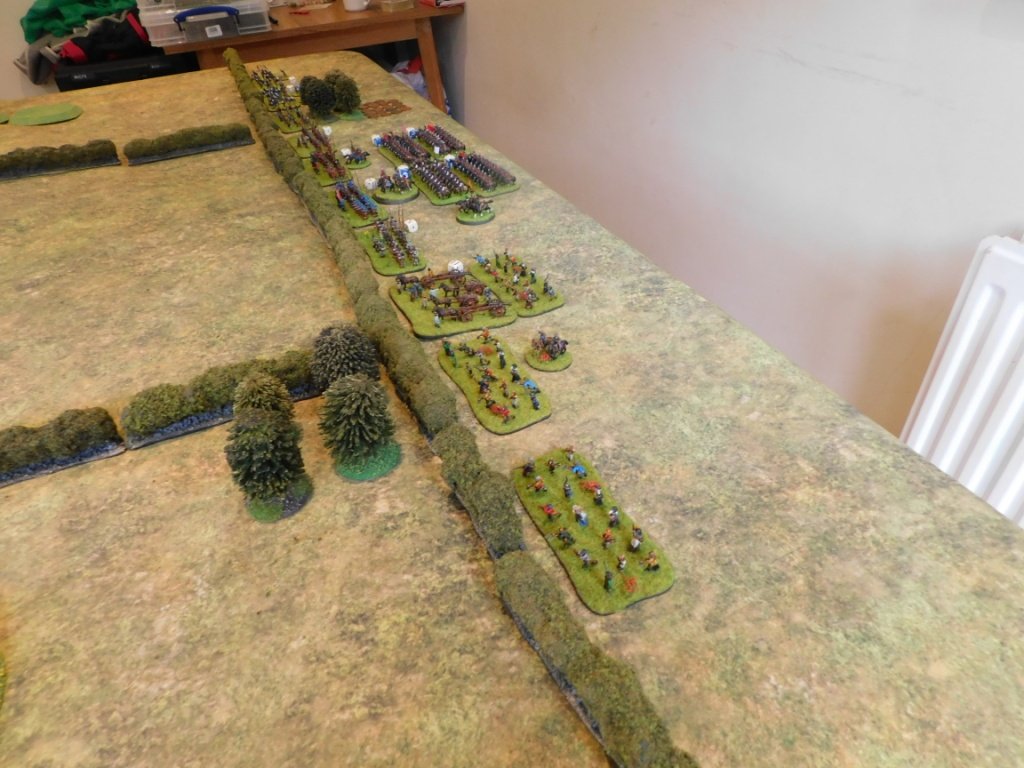
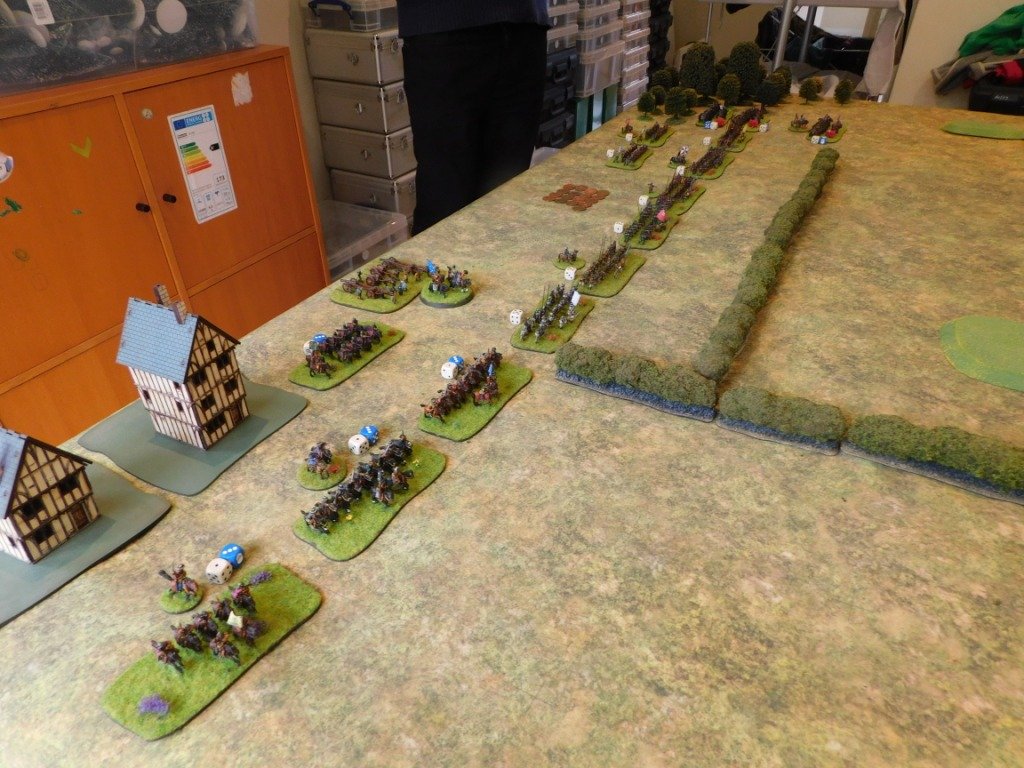
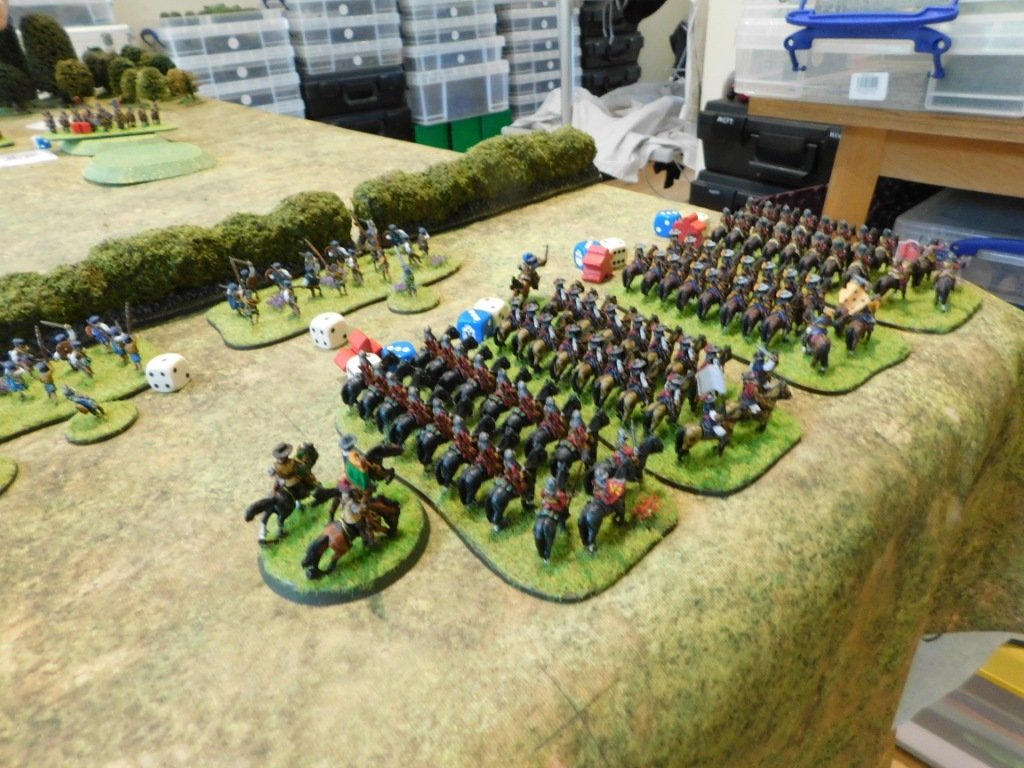
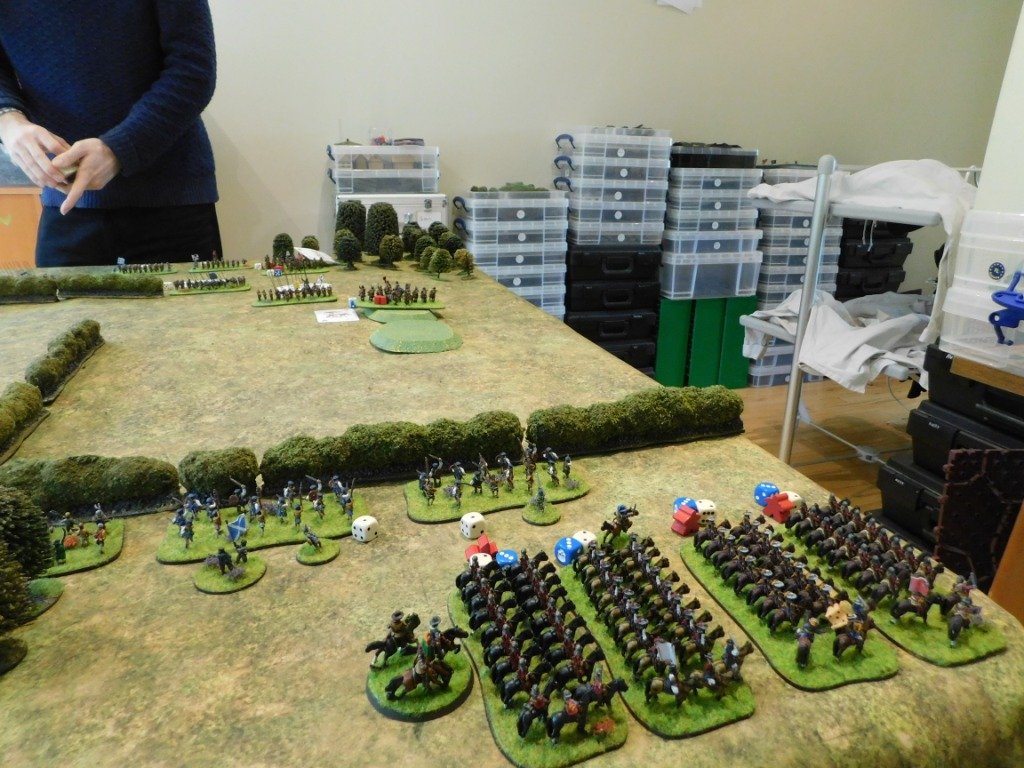
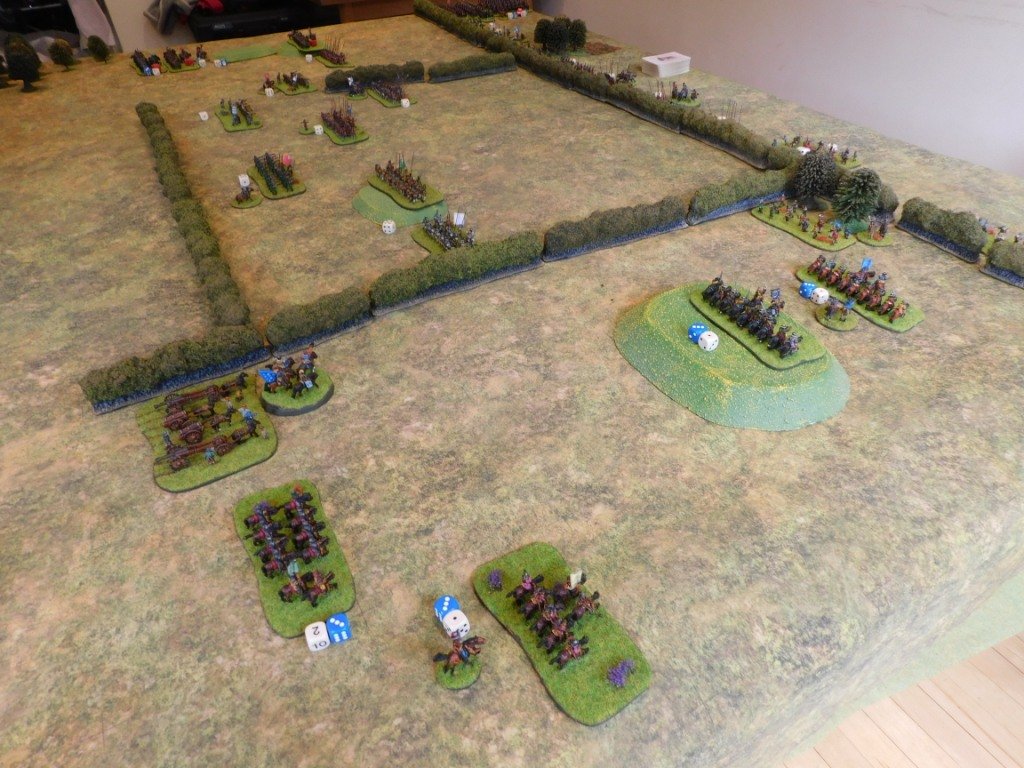
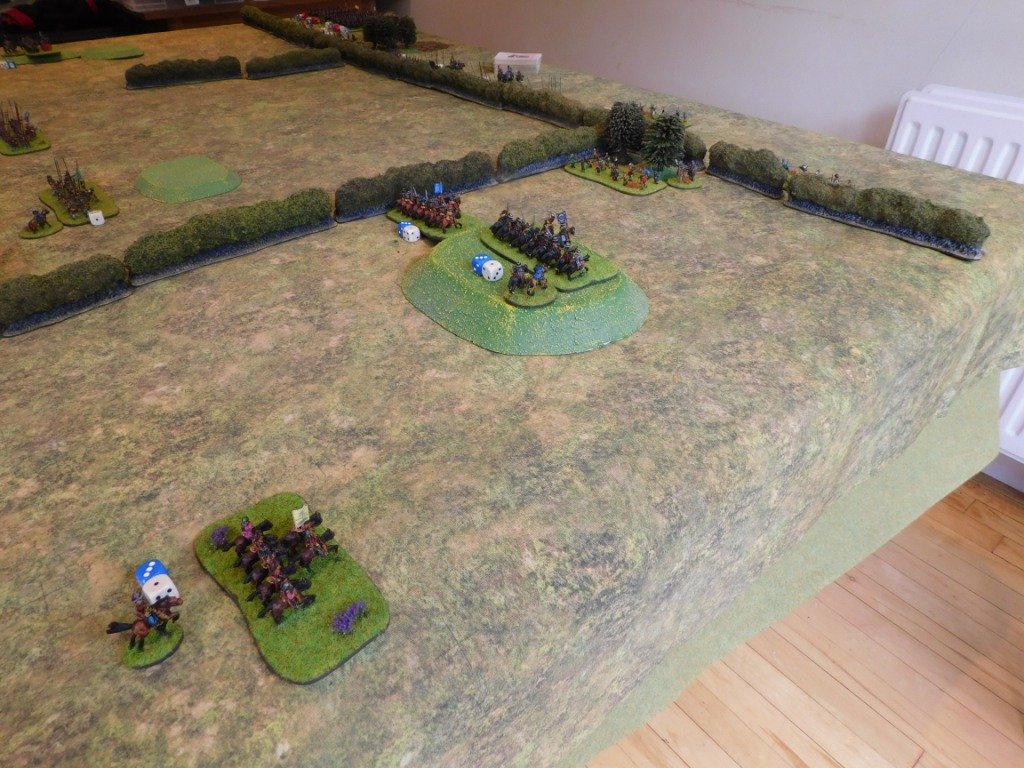
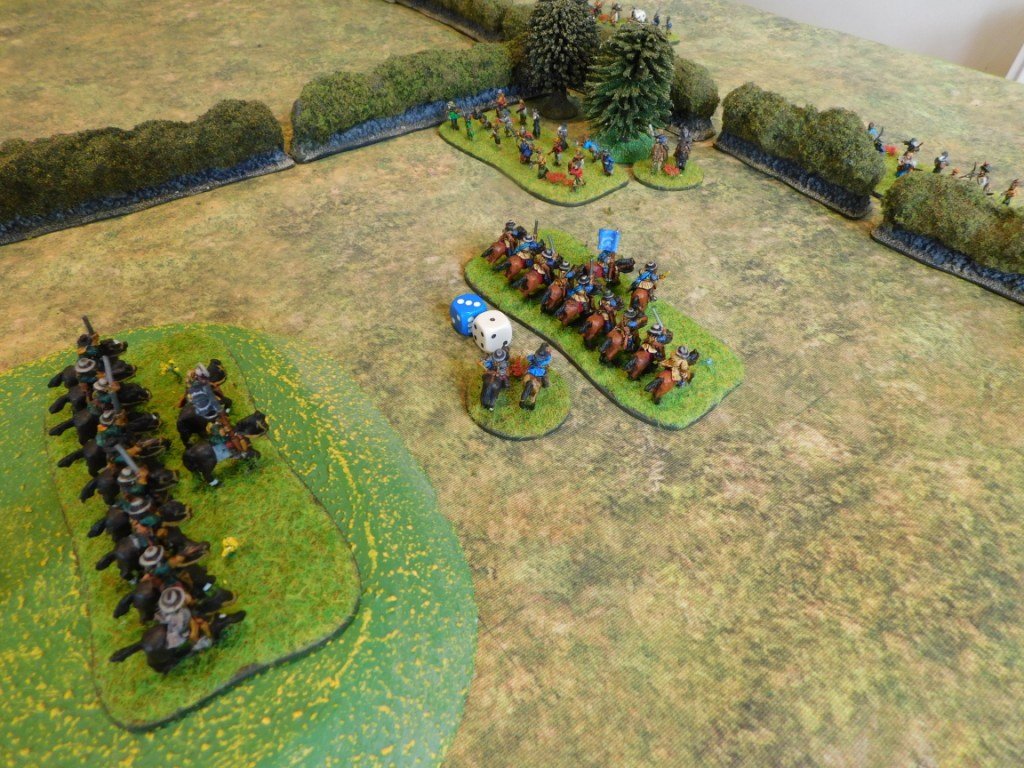
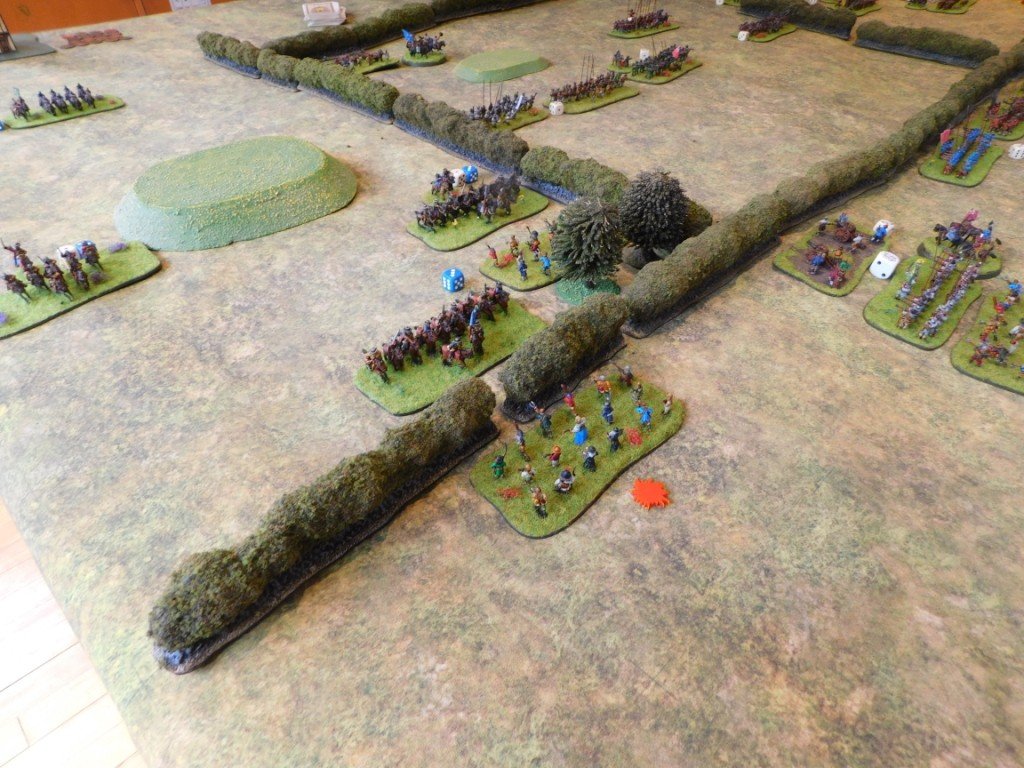
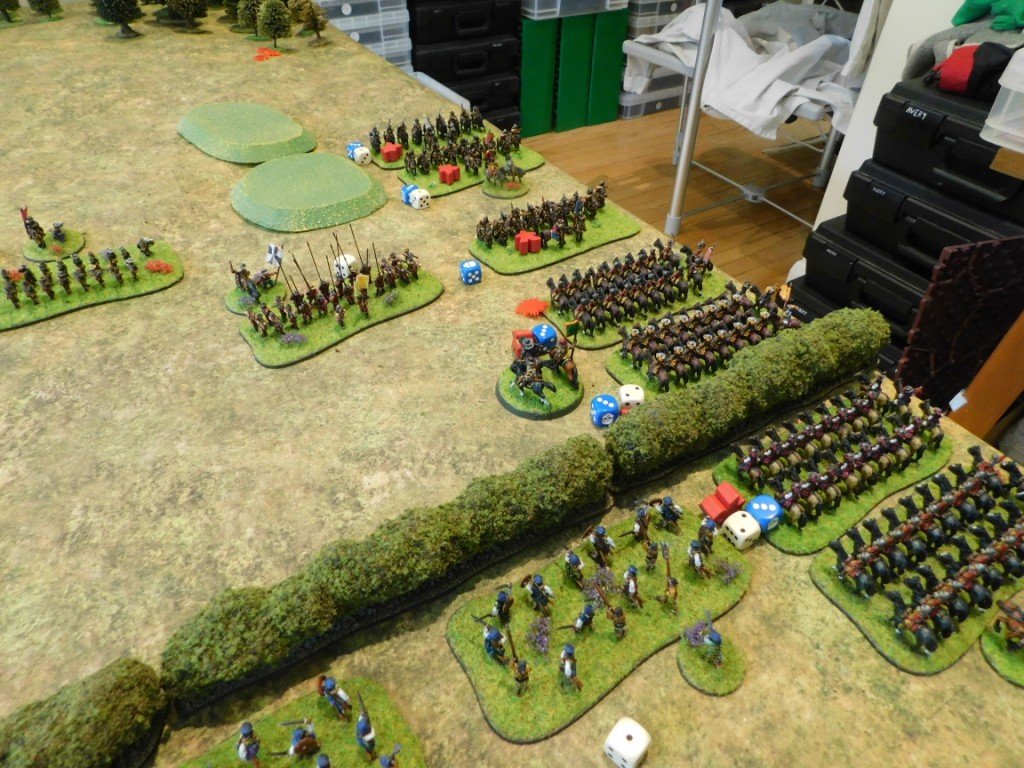
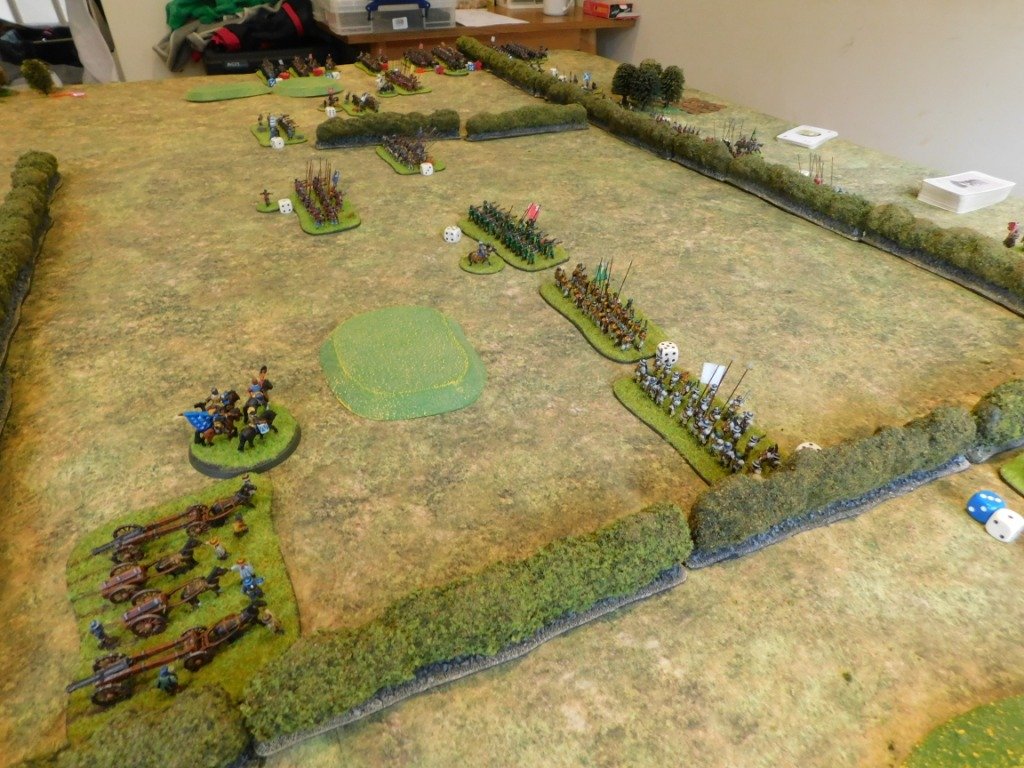
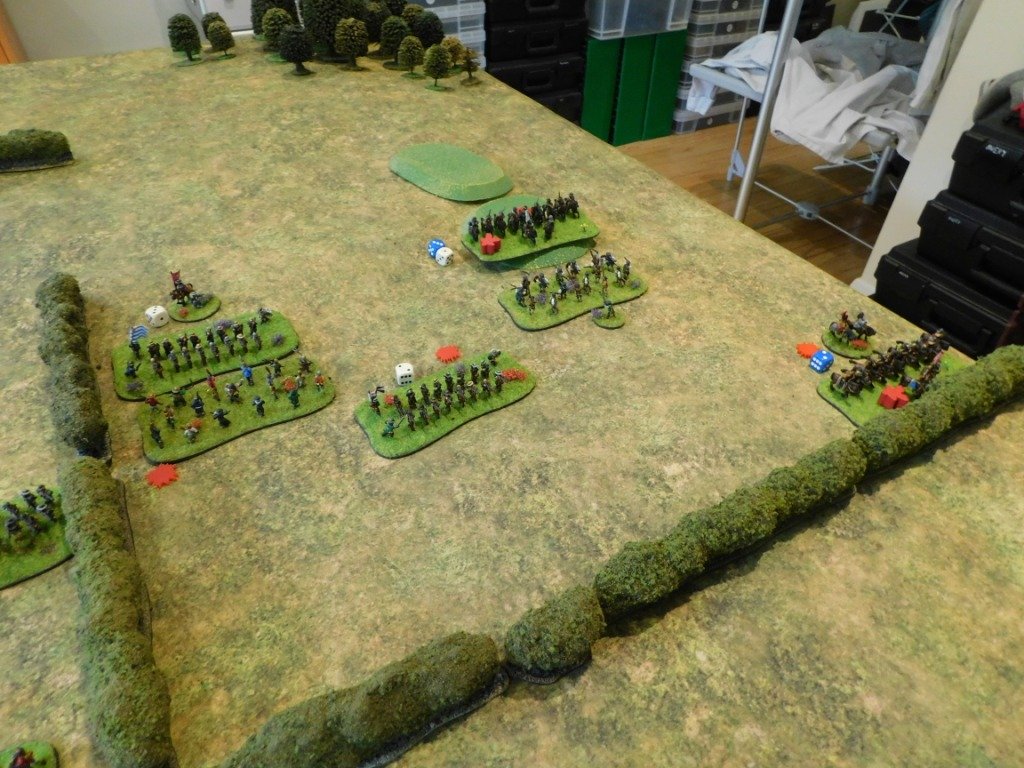
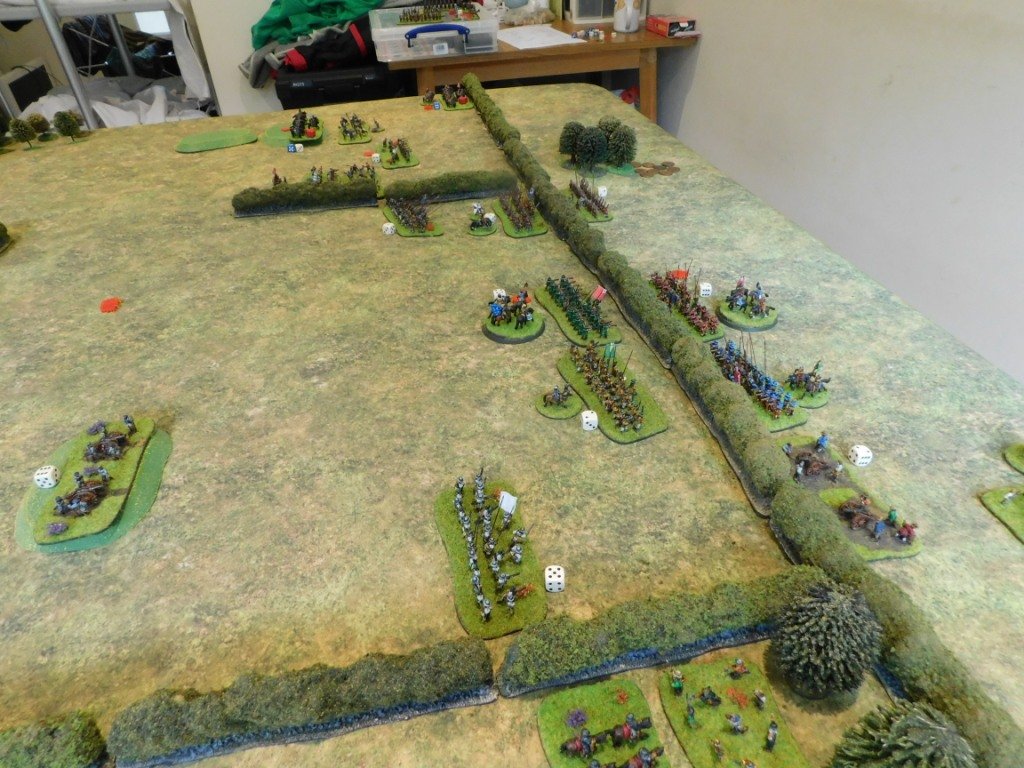
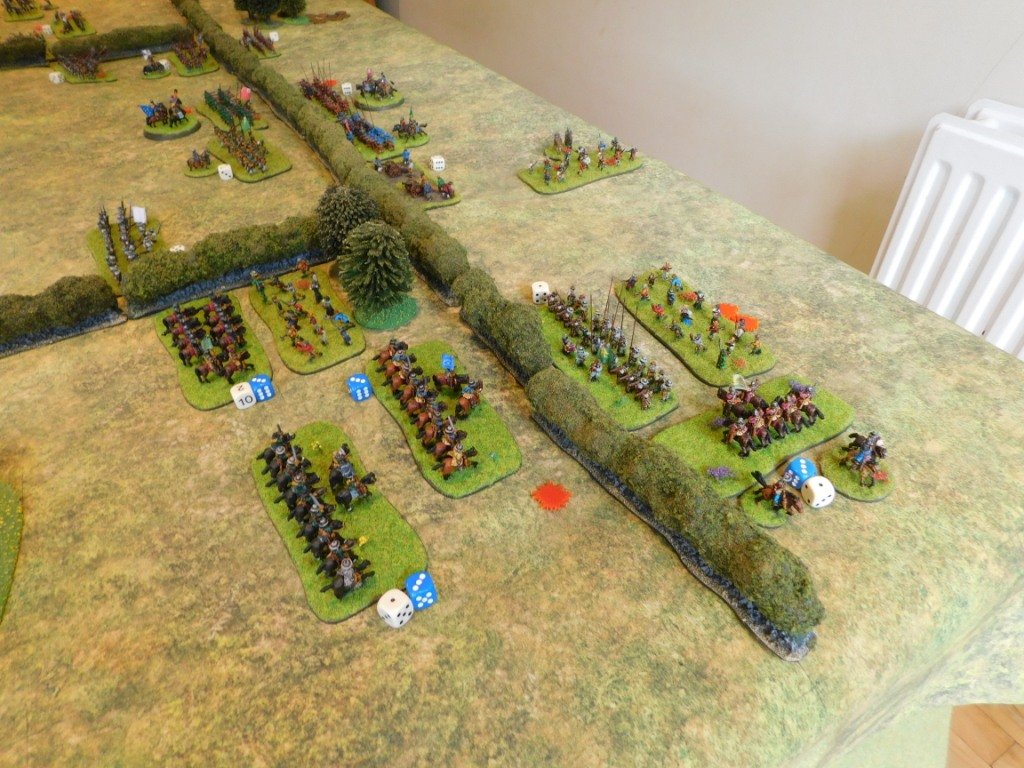
The Attack on Marlowe
Meanwhile, blogger Zanoni has started playing through my previous ECW scenario pack: Marlowe to Maidenhythe, which is now available in both digital and physical form.
His first AAR, covering scenario #1 The Attack on Marlowe has lots of pictures of his beautifully painted collection of ECW figures. Recommended as a feast of eye candy!
Click here to see the report on his excellent Troop Time! blog.









































